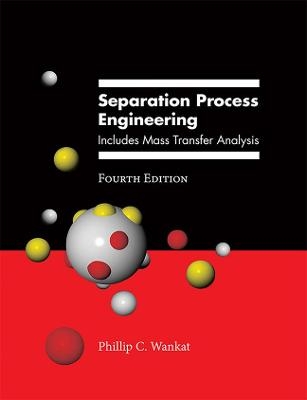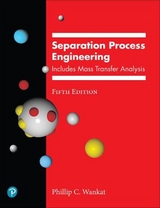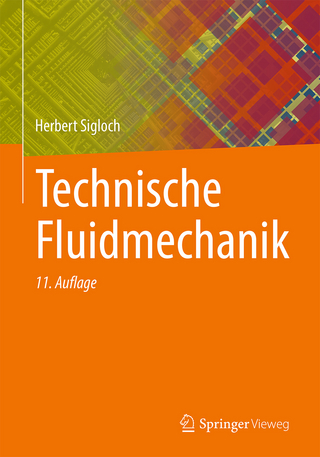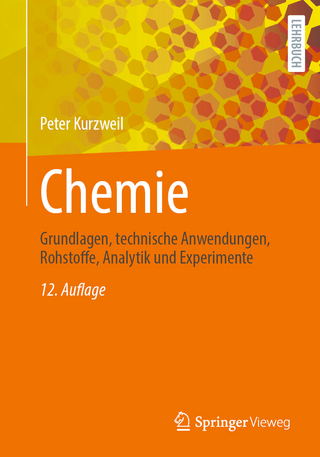
Separation Process Engineering
Pearson (Verlag)
978-0-13-344365-3 (ISBN)
- Titel erscheint in neuer Auflage
- Artikel merken
Separation Process Engineering, Fourth Edition, is the most comprehensive, accessible guide available on modern separation processes and the fundamentals of mass transfer. In this completely updated edition, Phillip C. Wankat teaches each key concept through detailed, realistic examples using real data—including up-to-date simulation practice and spreadsheet-based exercises.
Wankat thoroughly covers each separation process, including flash, column, and batch distillation; exact calculations and shortcut methods for multicomponent distillation; staged and packed column design; absorption; stripping; and more. This edition provides expanded coverage of mass transfer and diffusion, so faculty can cover separations and mass transfer in one course.
Detailed discussions of liquid-liquid extraction, adsorption, chromatography, and ion exchange prepare students for advanced work. Wankat presents coverage of membrane separations, including gas permeation, reverse osmosis, ultrafiltration, pervaporation, and applications. An updated chapter on economics and energy conservation in distillation adds coverage of equipment costs.
This edition contains more than 300 new, up-to-date homework problems, extensively tested in undergraduate courses at Purdue University and the University of Canterbury (New Zealand).
Coverage includes
New chapter on crystallization from solution, including equilibrium, chemical purity, crystal size distribution, and pharmaceutical applications
Thirteen up-to-date Aspen Plus process simulation labs, adaptable to any simulator
Eight detailed Aspen Chromatography labs
Extensive new coverage of ternary stage-by-stage distillation calculations
Fraction collection and multicomponent calculations for simple batch distillation
New mass transfer analysis sections on numerical solution for variable diffusivity
Mass transfer to expanding or contracting objects, including ternary mass transfer
Expanded coverage of pervaporation
Updated Excel spreadsheets offering more practice with distillation, diffusion, mass transfer, and membrane separation problems
Phillip C. Wankat is the Clifton L. Lovell Distinguished Professor of Chemical Engineering and Engineering Education at Purdue University. His research interests include adsorption, large-scale chromatography, simulated moving bed systems, distillation, and improvements in engineering education. He received Purdue University’s highest faculty award, the Morrill Award, in 2016. With K. S. Knaebel, he contributed the Mass Transfer section to Perry’s Chemical Engineers’ Handbook, Eighth Edition (McGraw-Hill, 2008).
Preface xix
Acknowledgments xxi
About the Author xxiii
Nomenclature xxv
Chapter 1: Introduction to Separation Process Engineering 1
1.0. Summary—Objectives 1
1.1. Importance of Separations 1
1.2. Concept of Equilibrium 3
1.3. Mass Transfer Concepts 4
1.4. Problem-Solving Methods 5
1.5. Units 7
1.6. Computers and Computer Simulations 8
1.7. Prerequisite Material 8
1.8. Other Resources on Separation Process Engineering 9
References 11
Homework 12
Chapter 2: Flash Distillation 15
2.0. Summary—Objectives 15
2.1. Basic Method of Flash Distillation 15
2.2. Form and Sources of Equilibrium Data 17
2.3. Graphical Representation of Binary VLE 20
2.4. Binary Flash Distillation 25
2.5. Multicomponent VLE 32
2.6. Multicomponent Flash Distillation 36
2.7. Simultaneous Multicomponent Convergence 42
2.8. Three-Phase Flash Calculations 47
2.9. Size Calculation 48
2.10. Using Existing Flash Drums 53
References 54
Homework 55
Appendix A. Computer Simulation of Flash Distillation 67
Appendix B. Spreadsheets for Flash Distillation 77
Chapter 3: Introduction to Column Distillation 81
3.0. Summary—Objectives 81
3.1. Developing a Distillation Cascade 82
3.2. Distillation Equipment 88
3.3. Specifications 90
3.4. External Column Balances 94
References 98
Homework 98
Chapter 4: Binary Column Distillation: Internal Stage-by-Stage Balances 105
4.0. Summary—Objectives 105
4.1. Internal Balances 106
4.2. Binary Stage-by-Stage Solution Methods 110
4.3. Introduction to the McCabe-Thiele Method 116
4.4. Feed Line 120
4.5. Complete McCabe-Thiele Method 128
4.6. Profiles for Binary Distillation 132
4.7. Open Steam Heating 132
4.8. General McCabe-Thiele Analysis Procedure 138
4.9. Other Distillation Column Situations 146
4.10. Limiting Operating Conditions 151
4.11. Efficiencies 154
4.12. Simulation Problems 156
4.13. New Uses for Old Columns 158
4.14. Subcooled Reflux and Superheated Boilup 159
4.15. Comparisons Between Analytical and Graphical Methods 161
References 162
Homework 163
Appendix A. Computer Simulation of Binary Distillation 179
Appendix B. Spreadsheets for Binary Distillation 183
Chapter 5: Introduction to Multicomponent Distillation 189
5.0. Summary—Objectives 189
5.1. Calculational Difficulties 189
5.2. Profiles for Multicomponent Distillation 194
5.3. Stage-by-Stage Calculations for CMO 199
References 206
Homework 206
Appendix A. Simplified Spreadsheet for Stage-by-Stage Calculations for Ternary Distillation 212
Appendix B. Automated Spreadsheet with VBA for Stage-by-Stage Calculations for Ternary Distillation 215
Chapter 6 Exact Calculation Procedures for Multicomponent Distillation 219
6.0. Summary—Objectives 219
6.1. Introduction to Matrix Solution for Multicomponent Distillation 219
6.2. Component Mass Balances in Matrix Form 221
6.3. Initial Guesses for Flow Rates and Temperatures 225
6.4. Temperature Convergence 225
6.5. Energy Balances in Matrix Form 229
6.6. Introduction to Naphtali-Sandholm Simultaneous Convergence Method 232
6.7. Discussion 233
References 234
Homework 235
Appendix. Computer Simulations for Multicomponent Column Distillation 241
Chapter 7: Approximate Shortcut Methods for Multicomponent Distillation 249
7.0. Summary—Objectives 249
7.1. Total Reflux: Fenske Equation 250
7.2. Minimum Reflux: Underwood Equations 254
7.3. Gilliland Correlation for Number of Stages at Finite Reflux Ratios 259
References 263
Homework 263
Chapter 8: Introduction to Complex Distillation Methods 271
8.0. Summary—Objectives 271
8.1. Breaking Azeotropes with Other Separators 272
8.2. Binary Heterogeneous Azeotropic Distillation Processes 273
8.3. Steam Distillation 282
8.4. Pressure-Swing Distillation Processes 286
8.5. Complex Ternary Distillation Systems 287
8.6. Extractive Distillation 296
8.7. Azeotropic Distillation with Added Solvent 302
8.8. Distillation with Chemical Reaction 306
References 309
Homework 310
Appendix A. Simulation of Complex Distillation Systems 326
Appendix B. Spreadsheet for Residue Curve Generation 336
Chapter 9: Batch Distillation 339
9.0. Summary—Objectives 339
9.1. Introduction to Batch Distillation 339
9.2. Batch Distillation: Rayleigh Equation 341
9.3. Simple Binary Batch Distillation 344
9.4. Constant-Mole Batch Distillation 349
9.5. Batch Steam Distillation 350
9.6. Multistage Binary Batch Distillation 352
9.7. Multicomponent Simple Batch Distillation 357
9.8. Operating Time 361
References 362
Homework 363
Appendix A. Spreadsheet for Simple Multicomponent Batch Distillation, Constant Relative Volatility 372
Chapter 10: Staged and Packed Column Design 375
10.0. Summary—Objectives 375
10.1. Staged Column Equipment Description 376
10.2. Tray Efficiencies 385
10.3. Column Diameter Calculations 390
10.4. Balancing Calculated Diameters 396
10.5. Sieve Tray Layout and Tray Hydraulics 398
10.6. Valve Tray Design 404
10.7. Introduction to Packed Column Design 406
10.8. Packings and Packed Column Internals 406
10.9. Height of Packing: HETP Method 409
10.10. Packed Column Flooding and Diameter Calculation 411
10.11. Economic Trade-Offs for Packed Columns 417
10.12. Choice of Column Type 418
References 421
Homework 425
Appendix. Tray and Downcomer Design with Computer Simulator 433
Chapter 11: Economics and Energy Conservation in Distillation 437
11.0. Summary—Objectives 437
11.1. Equipment Costs 438
11.2. Basic Heat Exchanger Design 443
11.3. Design and Operating Effects on Costs 445
11.4. Changes in Plant Operating Rates 454
11.5. Energy Conservation in Distillation 455
11.6. Synthesis of Column Sequences for Almost Ideal Multicomponent Distillation 460
11.7. Synthesis of Distillation Systems for Nonideal Ternary Systems 466
References 470
Homework 472
Chapter 12: Absorption and Stripping 481
12.0. Summary—Objectives 482
12.1. Absorption and Stripping Equilibria 483
12.2. McCabe-Thiele Solution for Dilute Absorption 485
12.3. Stripping Analysis for Dilute Systems 489
12.4. Analytical Solution for Dilute Systems: Kremser Equation 490
12.5. Efficiencies 496
12.6. McCabe-Thiele Analysis for More Concentrated Systems 497
12.7. Column Diameter 501
12.8. Dilute Multisolute Absorbers and Strippers 502
12.9. Matrix Solution for Concentrated Absorbers and Strippers 504
12.10. Irreversible Absorption and Cocurrent Cascades 508
References 510
Homework 511
Appendix. Computer Simulations of Absorption and Stripping 520
Chapter 13: Liquid-Liquid Extraction 527
13.0. Summary—Objectives 527
13.1. Extraction Processes and Equipment 527
13.2. Dilute, Immiscible, Countercurrent Extraction 532
13.3. Dilute Fractional Extraction 539
13.4. Immiscible Single-Stage and Cross-Flow Extraction 543
13.5. Concentrated Immiscible Extraction 547
13.6. Immiscible Batch Extraction 551
13.7. Extraction Equilibrium for Partially Miscible Ternary Systems 553
13.8. Mixing Calculations and the Lever-Arm Rule 556
13.9. Partially Miscible Single-Stage and Cross-Flow Systems 558
13.10. Countercurrent Extraction Cascades for Partially Miscible Systems 561
13.11. Relationship Between McCabe-Thiele and Triangular Diagrams for Partially Miscible Systems 569
13.12. Minimum Solvent Rate for partially Miscible Systems 570
13.13. Extraction Computer Simulations 572
13.14. Design of Mixer-Settlers 573
References 586
Homework 588
Appendix. Computer Simulation of Extraction 598
Chapter 14: Washing, Leaching, and Supercritical Extraction 603
14.0. Summary—Objectives 603
14.1. Generalized McCabe-Thiele and Kremser Procedures 603
14.2. Washing 606
14.3. Leaching with Constant Flow Rates 610
14.4. Leaching with Variable Flow Rates 612
14.5. Introduction to Supercritical Fluid Extraction 615
14.6. Application of McCabe-Thiele and Kremser Methods to Other Separations 617
References 618
Homework 619
Chapter 15: Introduction to Diffusion and Mass Transfer 627
15.0. Summary–Objectives 629
15.1. Molecular Movement Leads to Mass Transfer 629
15.2. Fickian Model of Diffusivity 631
15.3. Values and Correlations for Fickian Binary Diffusivities 647
15.4. Linear Driving-Force Model of Mass Transfer for Binary Systems 656
15.5. Correlations for Mass Transfer Coefficients 670
15.6. Difficulties with Fickian Diffusion Model 682
15.7. Maxwell-Stefan Model of Diffusion and Mass Transfer 683
15.8. Advantages and Disadvantages of Different Diffusion and Mass Transfer Models 698
References 698
Homework 700
Appendix. Spreadsheets Examples 15-10 and 15-11 707
Chapter 16: Mass Transfer Analysis for Distillation, Absorption, Stripping, and Extraction 711
16.0. Summary—Objectives 711
16.1. HTU-NTU Analysis of Packed Distillation Columns 712
16.2. Relationship of HETP and HTU 720
16.3. Mass Transfer Correlations for Packed Towers 723
16.4. HTU-NTU Analysis of Concentrated Absorbers and Strippers 731
16.5. HTU-NTU Analysis of Cocurrent Absorbers 736
16.6. Prediction of Distillation Tray Efficiency 738
16.7. Mass Transfer Analysis of Extraction 741
16.8. Rate-Based Analysis of Distillation 753
References 756
Homework 758
Appendix. Computer Rate-Based Simulation of Distillation 765
Chapter 17: Crystallization from Solution 769
17.0. Summary–Objectives 769
17.1. Basic Principles of Crystallization from Solution 770
17.2. Continuous Cooling Crystallizers 776
17.3. Evaporative and Vacuum Crystallizers 785
17.4. Sieve Analysis 793
17.5. Introduction to Population Balances 798
17.6. Crystal Size Distributions for MSMPR Crystallizers 800
17.7 Seeding 814
17.8. Batch and Semibatch Crystallization 820
17.9. Precipitation 825
References 828
Homework 830
Appendix. Spreadsheets 836
Chapter 18: Introduction to Membrane Separation Processes 837
18.0. Summary—Objectives 838
18.1. Membrane Separation Equipment 840
18.2. Membrane Concepts 843
18.3. Gas Permeation 845
18.4. Reverse Osmosis (RO) 862
18.5. Ultrafiltration (UF) 877
18.6. Pervaporation (Pervap) 883
18.7. Bulk Flow Pattern Effects 895
References 899
Homework 901
Appendix. Spreadsheet for Crossflow Gas Permeation 914
Chapter 19: Introduction to Adsorption, Chromatography, and Ion Exchange 917
19.0. Summary—Objectives 918
19.1. Sorbents and Sorption Equilibrium 918
19.2. Solute Movement Analysis for Linear Systems: Basics and Applications to Chromatography 930
19.3. Solute Movement Analysis for Linear Systems: Temperature and Pressure Swing Adsorption and Simulated Moving Beds 938
19.4. Nonlinear Solute Movement Analysis 961
19.5. Ion Exchange 970
19.6. Mass and Energy Transfer in Packed Beds 978
19.7. Mass Transfer Solutions for Linear Systems 985
19.8. LUB Approach for Nonlinear Sorption Systems 993
19.9. Checklist for Practical Design and Operation 998
References 1000
Homework 1003
Appendix. Aspen Chromatography Simulator 1019
Appendix A: Aspen Plus Troubleshooting Guide for Separations 1047
Appendix B: Instructions for Fitting VLE and LLE Data with Aspen Plus 1051
Appendix C: Unit Conversions and Physical Constants 1053
Appendix D: Data Locations 1055
Answers to Selected Problems 1065
Index 1073
| Erscheinungsdatum | 02.09.2016 |
|---|---|
| Sprache | englisch |
| Maße | 185 x 236 mm |
| Gewicht | 1800 g |
| Themenwelt | Naturwissenschaften ► Chemie ► Technische Chemie |
| Technik ► Umwelttechnik / Biotechnologie | |
| ISBN-10 | 0-13-344365-5 / 0133443655 |
| ISBN-13 | 978-0-13-344365-3 / 9780133443653 |
| Zustand | Neuware |
| Informationen gemäß Produktsicherheitsverordnung (GPSR) | |
| Haben Sie eine Frage zum Produkt? |
aus dem Bereich



